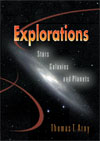Beyond the edge of the Milky Way and filling the depths of space are millions
of other star systems similar to our own. These remote, immense star clouds
are called "external galaxies," and their properties are the subject
of this chapter. Many external galaxies are flattened systems with spiral arms,
similar to the Milky Way in size and shape. Other external galaxies differ dramatically
from our own. For example, many galaxies are not disk-shaped at all. Rather,
they are egg-shaped, with their stars distributed in a vast, smooth cloud surrounding
a dense central core of stars. Others are neither disks nor smooth elliptical
shapes but are completely irregular in appearance. Galaxies differ in more than shape; they also differ in their contents.
Some contain mostly old stars, but others contain predominantly young stars.
Some are rich in interstellar matter, but others have hardly any at all. Some
galaxies, despite having as much total mass as the Milky Way, have formed far
fewer stars, leaving them dim and scarcely visible to us. Others have a small
but tremendously powerful energy source at their core that emits as much energy
as the entire Milky Way but from a region about 0.001% its size, less than a
few light-years in diameter. Many of these so-called active galactic nuclei
eject gas in narrow jets at nearly the speed of light. Galaxies are not spread uniformly across the sky. Just as stars often lie
in clusters, so too galaxies often lie in galaxy clusters and galaxy clusters
themselves lie in clusters of galaxy clusters. These immense groups are not
stationary. They are separating from one another, caught up in the expansion
of the Universe, like snowflakes carried on the wind. Astronomers can see all this diversity in galaxies, but as yet they understand
only poorly how it arises. Unlike stars, whose structure and evolution are well
understood, many aspects of galaxies remain a mystery. Astronomers do not even
agree on why some galaxies are disks, whereas others are egg-shaped. Although
this lack of knowledge is frustrating to astronomers, it does offer us a chance
to see how scientists work, in particular, how astronomers begin with basic
observations and go on to construct hypotheses to explain what they observe.
For example, many galaxies appear to be undergoing collisions with their neighbors.
Could past interactions of this kind account for the different galaxy shapes? |



 2002 McGraw-Hill Higher Education
2002 McGraw-Hill Higher Education